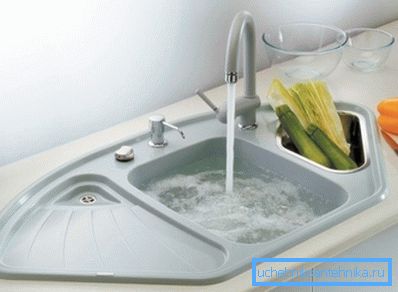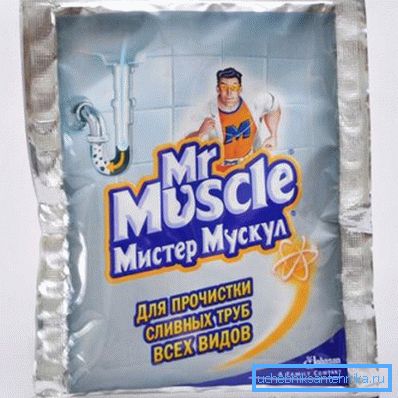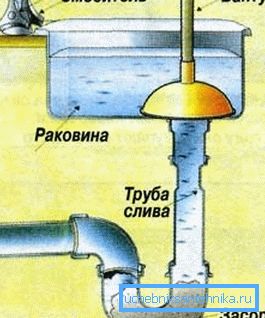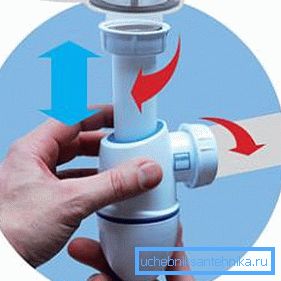How to remove blockage in the sink: 3 least time-consuming
When the water drain slows down and then stops altogether, we begin to think about how to remove the clog in the sink. And even though this task is not complex, it is worth preparing to approach its solution. Then the cleaning will be faster, and more serious procedures will not be needed.
Below we describe how to cope with blockages, as well as a number of tips on how to prevent the formation of traffic jams in pipes and siphons.

Cleaning procedures
Method one: hot water
So, what to do - if the sink in the bathroom or in the kitchen is clogged?
Until the problem has gone too far, i.e. Stock also functions, albeit with a reduced capacity, you can try to handle hot water.
We proceed in this way:

- On the stove we heat a large pot of water (we need five liters, no less). You can not bring to a boil, but the liquid must be very hot.
Note! If the water in the pot is boiling, let it cool for 5-10 minutes. This is done in order not to damage the plastic parts of the pipeline with boiling water, which can deform under the influence of high temperature.
- Carefully bring water to the bathroom and pour it into the problem drain. It is desirable that all the liquid immediately went into the pipes - so that some of the pollution will simply be washed away with a stream.
- We stand for about a quarter of an hour, after which we perform a generous washing with warm or cold water.
In most cases, it helps to cope with fat deposits: hot water helps dissolve them, and subsequent flushing removes all excess particles.
Method Two: Chemicals
If temperature treatment does not help, then the instruction recommends using different chemical compounds. They are available either in the form of powders or in the form of gels, and are intended to destroy the blockages of medium density.

You need to act like this:
- Pour out the powder from the bag into the sink drain, then pour about 200 ml of warm water into it.
Note! The tool is quite aggressive, so try not to allow it to fall on the skin, and even more so - on the mucous membranes.
- We give time for the reaction (from 10 minutes to half an hour, depending on the type of means used), and then flush with a large amount of water.
- If necessary, repeat the processing.
If you do not want to use toxic compounds, then it is quite possible to use folk remedies: when the sink is clogged, pour a few spoons of soda into it, add vinegar and pour 100 ml of water. Such flushing helps to cope with minor contaminations, while the risk of pipe destruction under the influence of chemical reagents will be minimal.
Method Three: Mechanical Pollution Removal
However, if all of the above methods did not help, you can always remove the blockage with your own hands.
Usually a plunger is used for this:

- The overflow hole is plugged or plugged with twisted rags to avoid pressure losses.
- Take the plunger and firmly press the rubber socket to the bottom of the sink.
- Pour into the sink a small amount of water. It is desirable that the entire rubber part of the plunger is hidden under a layer of liquid.
- We begin pumping the pipe, gradually increasing the amplitude of motion. The blockage in the sink will gradually collapse under hydraulic shocks.
- After completing 10-15 movements, sharply vdergivaem plunger. In this case, a negative pressure should form in the pipe, which will ensure the destruction of the blockage after draining the water left in the sink.
- If necessary, repeat the pumping two or three times, and then wash the pipes with warm water or use a chemical cleaning agent.
If we are talking about a kitchen sink, then often the place of formation of blockages becomes a siphon.
In this case, it is easiest to flush it:

- Close the tap to avoid water leaks.
- We put a rag under the sink, as there will always be a dirty liquid in the siphon and in the pipes.
- We disassemble siphon, unscrewing all captive nuts.
- Carefully dismantle the flask, trying to pour as little water as possible onto the floor.

- We take the drainage device to the bathroom, where we completely disassemble it and wash it with cleaning and disinfecting agents.
- While there is a possibility, we clean the open sewer drainage pipe with a cable or a simple piece of wire. You can also add to this nozzle a means of clogging the shell: this will prevent the formation of traffic jams in the future.
- We collect the siphon and install it in place.
- We check the tightness of all connections by performing a test drain.
Tip! Usually, after flushing, the fixation density of the flask is reduced, so experts recommend using sanitary plumbing for the thread immediately.
Prevention of blockages
In order to clean the sink less often, it’s worth following simple rules:
- Try not to flush objects not intended for this.. Large waste is better either to flush down the toilet or throw it in the garbage disposal.
- If possible, purchase and install a waste shredder.. This mechanism ensures the crushing of almost any material into the smallest parts, so that you can not be afraid of serious blockages.

- At least once a week, perform preventive rinsing, pouring 2-3 liters of hot water into the sink.
- Once a month fall asleep in the stock of clogs. The cost of such funds is relatively small, and they deal very well with prevention.
Conclusion
Defeating clogging in the sink can be done in many ways, but the above tips will require you to spend the least amount of time and effort. And yet it is much easier to pay attention to preventive measures and not to cause blockages.
The video in this article contains more detailed information about the causes of such a problem and how to solve it.